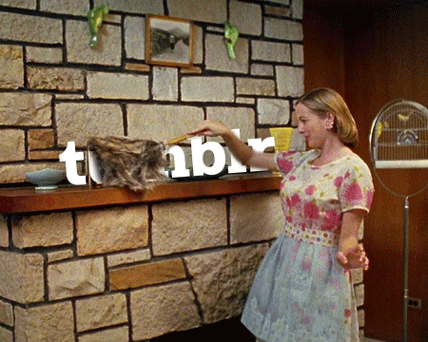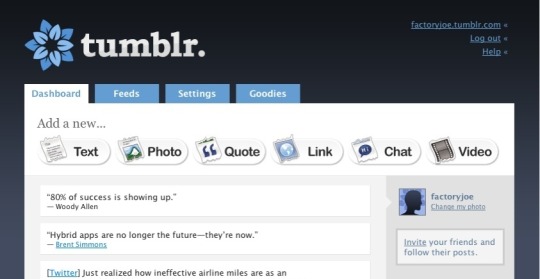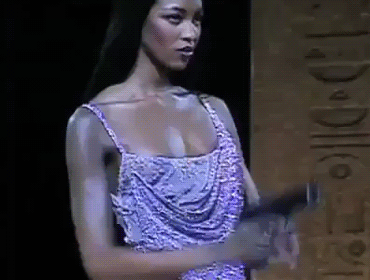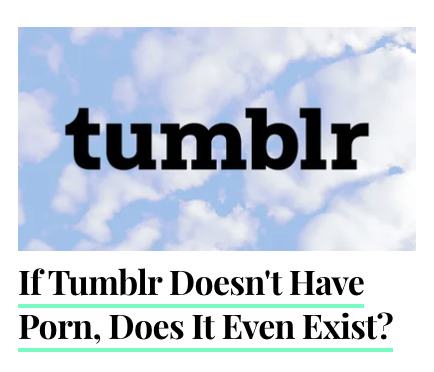Text
The Creation
Tumblr was launched in February 2007 in New York City by a 20-year-old Tech prodigy and web designer David Karp, who took an idea called "tumblelogging," and ran with it.

David started Tumblr to give users a different kind of blogging platform that was more free-form and less complicated. It wasn't a social networking site like Facebook that required you to "friend" other users. However, there was a community-building aspect to it - it was blogging (or microblogging, depending on who you asked) platform for sharing all sorts of media. Users initially used Tumblr as a mood board for their interests and personality. Where LiveJournal, Blogger, and Myspace blogs were mostly occupied by personal spiels or stories of thousands of words, Tumblr was different. Users were free to post shorter updates and mix them with lyrics, quotes, screenshots, and other images they just liked.

This experimentation spawned a culture that existed, initially, only on Tumblr. The focus on user experience led to functionalities such as Dashboard (live feed), Queueing, Tagging and even allowing HTML editing of blog themes were significant differentiators.

0 notes
Text

PRODUCTION (let's get a move on boys)
David Karp, the creator of Tumblr, was in the midst of a two-week gap between contracts at his software consulting company, Davidville (very modest David.) He had always been interested in tumblelogs, also know as short-form blogs that didn't necessarily have to be 1000 words or entirely coherent. Facebook, released in 2004, used similar styles to tumblelogs, but it relied more on the family and friend aspect of sharing news, rather than strangers on the internet with similar interests who may or may not become your next best friend. David sat in wait for an established blogging platform to take on tumblelogging on their app, but nobody did. David took it upon himself and today we have Tumblr. With a small team of creatives and a large engineering team, Tumblr was brought to life.
In 2013, Tumblr's previous Creative Director Peter Vidani in an interview by Art Technica layouts how many of the fruitful ideas for Tumblr's interface came to life. He mentions how free the team felt when building the original UX, feeling that the carefree energy that comes with tumblelogging translated to the workplace and actual designs.

"'The principles are, one, to be aware of everything you are asking the user to be aware of on the screen. Second, we keep the product (Tumblr) small and focused. We look to see if there are redundancies that can be taken out." -Peter Vidani
0 notes
Text

Let's break it down...
Tumblr Dashboard; 2007
Tumblr has always aimed for one thing: interconnectivity between people to form a community of those who share similar interests and beliefs. The original layout design of the app was simple and to the point, encouraging microblogging interactions and prolonged content viewing.
The interface of a Tumblr post has remained relatively similar throughout the years. Pictured above is the tumblr dashboard in april 2007, where a post could consist of a text, photo, quote, link, chat, or video. A dashboard to home all of your followings postings, as well as a feed to recommend newer, discovery-worthy content.

Tumblr Dashboard; 2011
Over time, the Tumblr dashboard remained strong in its design, only adding audio as a possible addition to any post. However, now you were boldy presented with how many people you are following as well as how many posts you've interacted with overall. Tumblr also adapted it's iconic indented layout, allowing comments and replies from users to be connected by bars,
such as this!

Tumblr Dashboard; 2024
The labels of the community are split into two: post-creating and post-viewing. This summarizes in the simplest way the function of Tumblr; to engage or to intrigue users into engaging.
When you first log into Tumblr, you are presented with the classic layout of a scrollable For You page (alongside a Following & Your tags), where you are encouraged to scroll and check out the latests post categorized by who and what tags you follow, as well as recommended content. This is all presented on the Home page, where you are prompted to make a posts at the very top, ushered to follow blogs that revolve around your similar interests, and prompts to further explore deeper into Tumblr where your interest typically would not lead you. Then, there is the explore page. This is where you can dive into an entirely new world of topics and conversations, ones not often found on your perfectly-curated For You page. While there is a section still recommending topics you are following, a majority of the Explore page is there to push you towards similar, yet branched out subjects that expand on what they already know about you. For example, I am into #yellowjackets, so why would I not also be interested in #cultmedia #sapphics #girlsgonewild & #splatterpunkbooks?
Activity, Messages, and Inbox all manage user interactions across the platform. Activity allows you to see how your friends or followers receive a post, sharing when if it was reblogged, liked, or created conversation. Messages and Inbox are relatively the same, but you can only send outgoing mail through Messages, and receives responses through your Inbox. It allows for a cleanliness, especially for larger blogs, while also posing a disconnect.
The Settings tab is similar in its layout to many social media platforms, giving you access and the availability to manipulate your account in whatever way you see fit. You can adjust the content you're seeing by blocking tags and bloggers, as well as filtering themes such as Drug Use, Violence, etc. In the same place, you are able to adjust your username or enact further Tumblr features that are in beta, called Tumblr Labs, "a collection of experiments we're working on that might turn out to be useful, fun, both, or neither." Tumblr allows you to manage any finances connected to your account, while simultaneously encouraging the user to give in to their small frees to allow for ad-free viewings of the app or having your very own, unique domain.
Tumblr Mart is one of the central monetization tactics used on the app. Badges, subscriptions, checkmarks, all at the tip of your fingers to further dazzle your blog, increase traffic, and showcase even more about you than was possible before. Purchase a zodiac badge to connect with your fellow Sagittarius', or showcase your playlist badge to let other bloggers know you have a wicked music taste. The Tumblr Mart encourages not only the beautifying of your own blog, but it encourages gifting other users matching badges or personal subscriptions as a means of showing affection. Love across the internet is just as powerful, right?

0 notes
Text

The Creation of Adam c. 1512 ; Michelangelo
so symbolic of the creation of tumblr don't ya think? it's almost as iconic!
0 notes
Text

Content from Inside; Bo Burnham
Tumblr is always advocating for the acceptance of any and all interests that a person can have (even the morally-convoluted ones...), creating a domain for millions of users to discuss what's often on their mind whenever they want.
From rich political discussions about the fascist dictatorship Spain was under during the creation of Microsoft, to not-so-deep shower thoughts phrased to sound as if they're coming out of a philosopher, to outlandish shitposts about Misha Collins and how a 49 year old man from a television show is Tumblr's babygirl <3.
0 notes
Text
the era of thinspiration and romanticization of mental illnesses

Tumblr is tragically iconic for being the homebase for a nasty social media trend that struck the internet around 2006 when the term was first coined, thinspiration. Society continued to push for thinness caused by eating disorders to be the standard of beauty, encouraging models that they had to deteriorate themselves from the inside out in order to not only be successful in the industry, but even viewed as worthy. Between 2006 and 2008, pro-anorexia and pro-bulimia social media posts increased by 470%. Thousands of posts a day were being spread like wildfire across the Tumblr app, antagonizing women for simply existing. Body guilt and food guilt were pushed onto others through the projections of pro-ana bloggers, creating a mass community of young teenage girls, typically around the age of 13-15 but also housed older teens as well, who encouraged one another to restrict their eating in order to achieve "beauty."
Fortunately, in February 2012, Tumblr banned any further posts including the tags or topic of "thinspo". Pinterest followed suit a month later, and not too longer after that, Instagram had banned the terms "thinspo" and "thinspiration" from the platform entirely, producing no results if those keywords were searched within the app, losing it's reputation as Thinspogram.

Although the banning of this topic across the largest social media platforms was a huge step in the right direction, it was impossible to erase every post and pin left behind from the years-worth of content still persuading young girls into destroying themselves for the sake of a number on a scale. Google searches still turn up decade old posts from all sites, leaving behind a dark trail of secrets in their pasts. This, also, did not stop the intense romanticization of mental illness across Tumblr.
While it went hand and hand with the #thinspo movement on the platform, romanticizing mental illness was at an all time high, using characters such as Cassie and Effy from SKINS as role models. Mental illnesses were seen as quirky personality traits rather than life-hindering illnesses. Self harm was paraded as self-discipline and beautifying your skin, pushing people away from the idea of ever entering "recovery". Recovery as a whole was made out to be unattainable. While many sought community on Tumblr to share their experiences and find solidarity, parasitic posters leeched onto vulnerable individuals with the goal to only further their suffering as a means of satisfying their own.

It's uplifting to see, now, how actively Tumblr works to combat the spread of thinspiration and other mental illness propaganda across the app. If you try to search triggering phrases such as "thinspo" or "sh", Tumblr gives the pursuer resources they can use to seek help. At the end of the day, humans are flawed and deeply scarred, and the internet (especially Tumblr) have created safe spaces for people to confide in one another.
0 notes
Text
Beachy sunset photos turned into close-ups of thin, bikini-clan bodies. Cut-off denim shorts morphed into a fixation on the gap between the legs wearing them. In the space of less than a year since I had created my Tumblr, there it was: the seemingly inevitable fall to pro-eating disorder content, thinly veiled under the guise of ♡pale soft grunge♡ aesthetic blogs.
0 notes
Text
Adult Content
Tumblr has always had a sizeable amount of pornographic content. An analysis conducted by news and technology site TechCrunch on May 20, 2013, showed that over 22% of all traffic in and out of Tumblr was classified as pornography.

Following July 2013 and its acquisition by Yahoo, Safe Mode (which filters "sensitive" content and blogs) became enabled by default for all users on an opt-out basis.
The feature had flaws. Users quickly found that it filtered out non-adult content, including LGBTQ+ posts.
Effective December 17, 2018, all images and videos depicting sex acts, and real-life images and videos depicting human genitalia or "female-presenting" nipples, would be banned from the service.

The change faced wide criticism among Tumblr's community; in particular, it has been argued that the service should have focused on other major issues (such as controlling hate speech or the number of porn-related spambots on the service), and that the service's adult community provided a platform for sex education, independent adult performers (especially those representing LGBT communities who feel that they are under-represented), and those seeking a safe haven from "over-policed" platforms to share creative work with adult themes.
0 notes
Text
There were tips for hiding an eating disorder from your family, how to burn off more calories than you consume, and at the peak of it, fatphobic rhetoric… When I'm feeling low or gross, even to this day, thoughts of restricting my caloric intake and punishing myself still flood back.
0 notes
Text

CHA-CHING! CHA-CHING!
On the internet, it is always a priority of blogs and posters to stand out among the rest, and luckily, Tumblr's micro-transactions allows you to achieve just that on the platform.
2012 was the year where Tumblr announced that it would be moving forward and joining other similar social media platforms in paid advertising on it's site. In June 2012, Tumblr collaborated with Adidas to feature its first ever major brand advertising campaign, where they launched an official soccer blog and bought ad placements to take up space on the user dashboard.
Tumblr uses a means of small, separate transactions that combined make your experience on Tumblr even better than ever before. Through the selling of ad-free scrolling or badges, subscriptions towards your favorite blogs (and the ability to tip those fabulous bloggers) and checkmarks to adorn your blog, Tumblr has been able to keep afloat, however that has never been entirely on it's own.
Tumblr was bought by Yahoo for a whopping $1 billion in 2013, but was later sold again to Automattic in 2019 for an astounding $3 million, comparably $97 million cheaper than it was only 6 years earlier. This can be attributed to the removal of porn from the app in order to maintain it's presence on the app store in 2018. Tumblr took a huge blog Upon Automattic stepping up as the parent company, that is when the micro-transactions on Tumblr skyrocketed in success, but not without some tumulteous reactions from the public first. Social media apps holding hands as they fall down the endless descent into capitalism felt unavoidable as the consumer watching it all go down. Tumblr introduced Post+ in 2021, a subscription to blogs that allowed you to see subscriber-only content from whatever blog you put money towards. Tumblr users were not pleased with this announcement, and the response was most definitely heard as Post+ was removed from the platform in January 2024. This, however, did not halt the triumph of ad-free viewing, as this turned out to be valuable to many frequent posters on the platform.
Then, Tumblr announced Blaze in 2022, a feature that allowed users to promote their posts, no matter how absurd they were. It wasn't a matter of promoting the most educational or controversial content, but rather postings that the blogger deemed necessary for the public to see (whatever those conditions may be). Not so sneakily, Blaze debuted on 4/20, costing the blogger only $4,20 to acquire the feature. According to TechCrunch journalist, Amanda Silberling, "Tumblr’s mobile app has seen approximately $507,000 in consumer spending since April."

0 notes
Text
412 notes
·
View notes
Text
i need feminism because when jesus does a magic trick it’s a goddamn miracle but when a woman does a magic trick she gets burned at the stake
1M notes
·
View notes
Text
THE TUMBLE OF TUMBLR
in 2013, The Tumblr team focused primarily on integration with Yahoo's technology systems (which were desktop-oriented). It didn’t align with the shift towards mobile in progress. And while Tumblr tinkered, competitors like Twitter, Instagram, and Facebook were rapidly developing.
Although a factor considered good by the users, Tumblr didn’t rely on knowing its users' true identities. So, while Tumblr was hugely popular and logically, every advertiser would have wanted access to its audience, the lack of individual user knowledge didn't work well for the advertisers, and they slowly started turning away, negatively impacting the revenue streams.

Tumblr has faced quite a few controversies and setbacks. The data for over 65 million user accounts was stolen in 2013 and offered for sale on the dark web. It was also banned by a few countries including China citing content related to terrorism, extremism, and pornography.
In its 2016 Annual Report, Yahoo ended up slashing Tumblr’s value by more than half to $482 million (down from $1.1 billion in 2013!).
And, then in June 2017, Verizon took over Yahoo and placed Tumblr under its Oath subsidiary (renamed Verizon Media in 2019). Almost immediately after the acquisition, the founder and CEO David Karp announced his departure.

0 notes
Text

new post but im shy so nobody gets to read it
10K notes
·
View notes

